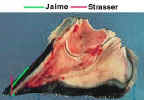
Treating Founder (Chronic Laminitis) without Horseshoes, Section 11
Faster-loading version with "thumbnail" photos
(Click on small photos to see larger versions)
Putting the wild horse foot shape to practical use
My illustration of "Backing Up the Point of Breakover" shows a cross-section of a normal hoof. This particular specimen has an over-long toe that is also slightly dished. The rounded green line is where Jaime Jackson (farrier and author of "The Natural Horse") rasps off the toe. This rolled shape is similar to how wild horse feet are naturally rounded off by getting a lot of exercise on abrasive terrain. Dr. Strasser backs up toes with a vertical cut in horses who have rotation, up to the white line so no toe wall is actually pressing in to the ground. You can see the front of this horse’s toe is forward of where they both trim.
"Backing Up the Point of Breakover"
A more detailed image of the subtly backed-up toe of a wild horse,
courtesy of Jaime Jackson's newsletter.
The end result of all the leverage that remained on my horse’s over-long toes and high heels, prying the hoof walls away from the laminae, was that Max's laminae remained stretched out to at least 3/4 of an inch wide at the toe for several years. I now blame this on misguided farrier work (toes not backed up enough and heels not lowered) and resets done too infrequently. At the time, I had resigned myself to the idea that Max would be permanently retired, at best.
Then I stumbled upon Jaime Jackson’s book, "The Natural Horse." This truly was a turning point for my poor old horse! Jaime is a horseman and a former farrier. He had studied wild horse herds, and was struck with the lack of lameness in these wild horses. This prompted him to do hoof studies of freshly-captured BLM mustangs. The mustangs were first admitted to the Litchfield, CA, facility, where they were roped by two wranglers. The front and hind legs were secured in pairs to allow worming, gelding, etc. This also was when Jaime measured and photographed their feet. He wanted to know more about what is truly natural for horses, as the soundness and sure-footedness of the wild horses convinced him the shape of wild feet was an ideal model for all horses. He now has enough data on wild horse feet to come to some conclusions about what nature truly intended for horses’ feet.
Since I started trimming Max myself, aiming for a wild horse-shaped foot, my horse has been having a dramatic turnaround.
Jaime's newer book, "The Horse Owners Guide to Natural Hoof Care," concentrates in more depth on hoof care than "The Natural Horse," but it was not released until April of '99. Also, in 2002 he came out with a revision of this second book that contradicts its first edition on a number of key points.
A summary of what I learned from Jaime on wild horse feet:
Wild Horse Feet, lateral views--From Jaime Jackson's "The Natural Horse"
More wild horse feet
Showing low heels and "passive frog contact"
--From Jaime Jackson's "The Natural Horse."
The ground surface of the wild horse hoof goes all the way back to the widest point of the frog--they are definitely not under-run. Low heels result in healthier soles and frogs. Rather than the foul, deeply recessed, tatty frogs seen in many domestic horses, separated from prominent high heels and bars by deep, narrow crevices (commissures), in wild horses, the low heels flow almost seamlessly into the frogs at the back of the foot, and the frogs are thin, firm and able to almost touch the ground towards the back of the frog. (Average wild frogs were only about 1/8 of an inch off the ground at the rear.) Wild frogs are pressed down into a flattened shape, almost flat with the sole towards the apex, and have the hardness of rawhide. Domestic frogs are thick, puffy and rubbery compared to wild frogs. When you lower the heels enough on domestic horses, the frogs may have to be pared to give the flattened-out shape, remove foul dead tissue and have a 1/8 inch clearance from the ground when the heels are low enough. This 1/8 inch clearance gives the frog "passive contact," meaning that the frog touches down slightly after the outer wall when the horse steps down on the foot. In trimming a domestic horse, lowering the heels, but not the frogs, so these puffy frogs protrude beyond the heels and quarter walls, will prevent hoof mechanism and result in a lot of pain.
Wild Horse Feet, solar views--From Jaime Jackson's "The Natural Horse"
Left, front sole--note symmetrical shape.
Center, hind sole--note asymmetrical shape, more mass on the outside of the median
(dotted line) than the inside, slightly shorter toe on outside corner of toe.
Right, right fore sole--note how concave the sole is and how flattened out the frog is.
An important note on the wild horse hoof model
Not all wild horses have optimum hoof shape and movement. Some terrain variations can change the overall shape of the hoof for the worse. Lyle "Bergy" Bergeleen mentions in his lectures that he had seen some wild horses who had been in exceptional drought conditions, and on very hard, abrasive terrain--having high heels, a more upright hoof form, and poor movement. The wild horses he saw who were in moister conditions, which also would mean the hooves were more flexible from being exposed to water more often, had much different hoof forms and were moving much better. The hooves Jaime Jackson studied, and which I show above, were more like those hooves under better terrain conditions.
Just because a horse was once wild doesn't mean he still has excellent hoof form! Check out some of the over-grown hooves at a BLM wild horse and burro sale in Columbus, OH, Feb. 10-13, 2006: Click HERE for BLM auction horse photos Some people go to these BLM auctions expecting to see excellent hooves. Many of the younger horses in the sale were actually born in captivity, as their mothers were pregnant at the time they were captured. Many adult horses had been in captivity long enough to lose their excellent hoof form.
For a fuller discussion, including many photos, on how terrain differences change wild horse hoof form by Dr. J. R. Rooney, author of "The Lame Horse":
Click here for Dr. J. R. Rooney article on the effect of terrain on wild horse hoof form
Their toes were short, averaging 3" Heavier horses had larger feet, measuring the length and width of the hoof at the ground plane, but still had short toes. Denise McLain has done some very interesting hoof comparisons showing that wider feet had coffin bone heights not proportionately larger than the width, which explains why these bigger feet did not have significantly longer toes.
Click here to see Denise McLain's coffin bone dissections and comparisons
Average toe angles were 54-5 front and 57-8 hind, although there was some latitude of + or – 2 degrees. This range included the great majority.
Wild feet leave rounder footprints. Measuring the bottoms of the feet, the length being from a line across the backs of the heel buttresses, to the toe: wild feet were, on average, only 1/4 of an inch longer than wide. Hind feet were, on average, 1/4 of an inch less in length and 1/4 of an inch less in width than front feet, and had a more pointed, slightly asymmetrical toe; fronts had a more rounded, symmetrical toe. Heel widths were the same for both front and hind feet, though. Domestic feet are often distorted into a more oblong shape, longer and narrower, due to high, contracted heels and a stretched-out hoof capsule resulting from long-term overlong toes and high heels. The point of breakover in wild feet usually did not exceed 1--1/4 inches to 1--1/2 inches in front of the apex of the frog, while this distance is often stretched out to a good 2 inches or even more in many domestic horses.
The Practical Applications of the wild hoof shape on Max's feet
Lowering Max's Heels Making Frogs and Soles Healthier
Left, October, l997. Frog is recessed and tatty because of overly high heels and bars. Also quarter flares due to high heels. Deep comissures more conducive to thrush and other infection. Quarter walls too long and flared because of high heels.
Right, February 1, l998. 6 weeks after the heels lowered, the frog is obviously healthier. No longer have quarter flares from overly high heels. This shape is also more "self-cleaning," more like a wild foot, which is a healthier scenario.
Left, December 21, l997, the day I first lowered the heels. White line the most solid-textured I'd seen it in 10 years. In retrospect, the heels were still not low enough!
Right, February 15, l998. Compare with December 21--the frog has widened and the heels spread considerably in 8 weeks since the heels lowered. White line continuing to get narrower. All photos are of right fore. I was not paring and shaping the sole and bars correctly here, though.
We want to trim the hoof capsule so that its shape parallels the shape of the underlying structure, which I was not doing too well above. I didn't concave the foot out enough to follow this shape:
(Photos courtesy of Jenny Edwards)
Please bear in mind that widening contracted heels can be a painful proposition for a while. In the long run, it is well worth doing, but it can be rough for a while. To quote Dr. Strasser from "A Lifetime of Soundness"--
| Dr. Strasser on opening contracted hooves:
"....during the treatment of contracted hooves, several aspects must be considered, many of which are similar to the transition from shod to barefoot, already discussed earlier. These include discomfort when circulation first returns to the hoof due to a restored hoof mechanism (like numb fingers from cold warming up again), sensitivity to point pressure (since the sole must be kept fairly thin to facilitate un-contraction), pain from the deformed lateral cartilages straightening out, some degree of inflammation (increased circulation necessary for normal healing) and an accompanying sensitivity to concussion, etc. It must also be understood that movement (on whatever ground the horse can tolerate) is vital to the reversal of contraction, especially during times of inflammation. Shutting a horse up in a stall not only delays healing, but can cause stocking up, inflammation, laminitis, etc. If natural living conditions are not possible, an attempt to open a contracted hoof should not be made. Nor should it be attempted without proper terrain. A horse with contracted hooves must have solid [but non-concussive] ground, and should not be moved any faster than a walk for at least 2-3 weeks. Hoof boots are good protection during the initial phase. Hoof abscesses must be expected within the first weeks to 2 years in most horses with any degree of contraction. These abscesses are not the result of puncture wounds or infections, but rather are the body's natural way of removing dead tissue (or tissue damaged beyond repair.) Movement is vital for an abscess to exit as quickly as possible, and to prevent swelling of the lower leg." [She then mentions soaking and poultices to speed drawing out abscesses.] ....Coffin bone deformation, often present if the hoof was contracted.........for a long time.........presents a very difficult and long-term rehabilitation, requiring up to 2 years until the hoof is completely restored to its normal shape. Laminitis, coffin bone rotation and/or protrusion may be expected if the contraction is severe and has been present for a long time, if the corium of the entire wall had had insufficient circulation for a long time, and the coffin bone suspension is greatly deteriorated. The time factor in reversing contraction is extremely unpredictable, [taking just weeks or many months]. If the owner is not willing to give the horse natural living conditions and reasonable time in which to heal, reversing contraction should not be attempted." Extremely contracted hoof--note high heels and bars. Dissection of a contracted hoof Fully open heels on a pony--an ideal to aspire to. |
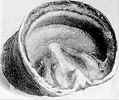
(Photo from Jaime Jackson's "The Natural Horse")
(Dissection photos courtesy of Jenny Edwards.)
The hoof capsule is really not all that thick. It is thin enough to have some give to it, so it can and does follow the shape of the internal structure. There are moving parts in there! It is not just a monolithic mass, like a solid block of wood. The best explanation I can come up with: If the base of support is continually kept rearwards with low heels and short, backed-up toes, more growth is stimulated in the entire foot, not just the toe. This enables the frog and sole to get more tamping, which creates callousing (thickening). When stronger laminae begin growing down due to improved circulation, the coffin bone will actually be lifted back up where it belongs, higher in the hoof capsule.
Growth being stimulated in the entire foot, rather than being stimulated mainly in the toe, is also reflected in hoof wall thickness; wild hooves have a more constant hoof wall thickness all the way around. In domestic horses, it is common to see hoof walls 2-3X thicker at the toe than in the quarters. In wild horses, there is less of a difference.
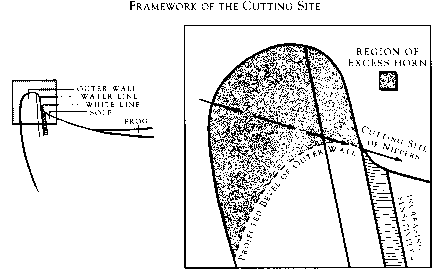
"Mustang Roll" Schematic from Jaime Jackson's "The Natural Horse," a trimming guide. The entire shaded area is removed.
Wild horses did not have dishing, flares, or deep ridges on the hoof wall.
Cross-sections of wild horse feet compared to domestic feet showed that the coffin bones in wild feet were actually higher up inside the hoof capsule, and that wild soles, digital cushions and walls were all thicker than their domestic counterparts. The increased use of the frog and sole also helps explain why wild horse feet have thicker soles, frogs and digital cushions. In a shod domestic horse, these areas atrophy from a lack of use because the hoof wall carries all the weight. This greater thickness, or "callusing," is stimulated by the tamping effect of lots of exercise on firm ground.
I believe that the thicker digital cushions, soles and frogs actually are what lift the coffin bone higher up inside the hoof capsule. Long-term overlong toes and high heels actually pull the coffin bone forwards, giving the coffin bone less support from the digital cushion, which allows the coffin bone to sink lower in the hoof capsule.
Please note that the distance from the apex of the frog to the point of breakover is proportionately much shorter in the wild foot than the domestic foot. In the wild foot, the toe area is compressed, from front to back. This longer distance in the domestic foot is the result of long-term over-long toes and high heels, which pull the coffin bone forward. In this forward position, the coffin bone does not get as much support from the frog.
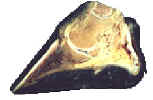
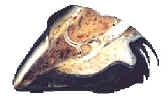
Left--Domestic foot, in cross-section. Right--Wild foot, in cross-section.
Despite low heels, hoof angles were still in the mid to upper 50’s, and even stranger, the hoof wall-pastern axis often appeared slightly "broken forward." This may seem hard to imagine until you realize that the hoof capsule is much more malleable than one might think. I later discovered that lowering the heels does not automatically lower the toe angles as much as I had expected, which it would if the hoof was as solid and unchangeable as a block of wood. Backing up the toe helps raise toe angles and encourages future growth to come in downwards instead of scooting forwards. Lowering the heels also allows the coffin bone to pull back more.
Breakover on the wild horse hoof is not over a sharp front edge of the hoof wall, jutting far out in front, but further back and actually over a sole callous, and because the edges of the hooves are rounded all the way around, especially in the toe. The mustang roll starts immediately in front of the white line area. This roundedness also makes the hooves less likely to chip, and eases breakover.
The low heels moving the heel buttresses backwards, and the breakover being further back, both shift the base of support rearwards, more under the bony leg column. One practical effect of this, resulting in my own horse's renewed athleticism, is that it makes it much easier for him to move and feel sure of himself…like the difference between us playing soccer in athletic shoes, as opposed to high-heeled pumps or platform shoes. Picture how much less athletic even a great athlete like Michael Jordan would be trying to play basketball in platform shoes. (OK, no Dennis-Rodman-in-high-heels jokes!)
Rasping out flares and dishing will encourage straighter growth in the future.
Keeping hooves constantly short stimulates faster growth, and speeds remodeling of the hoof capsule into a more natural shape. He also urges you to trim again when the hoof grows out 1/4 of an inch, however often this is, to maintain the benefits of a mustang-shaped foot.
Dr. Strasser's experiences would indicate trimming more often works even better. More info on Dr. Strasser's books:
www.TheHorsesHoof.com (Sells the books; online ordering and credit cards accepted.)
I have gotten feedback from readers who are now tweaking the trim 2-3x weekly. They notice progress accelerates with such frequent trims.
Other reasons Jaime believes so many domestic horses’ feet are inferior—
a. Working and housing them on soft ground at all times sacrifices the tamping from exercise on firm, dry ground. Without this tamping, the growth of thicker soles, frogs and hoof wall ("callousing") is not stimulated as much.
b. Many domestic horses do not get nearly enough exercise to stimulate callousing, either.
c. He also feels that constant excess moisture, either from wet stalls, muddy lots, or perspiration trapped in with hoof dressings, can weaken a hoof. Wild horses were on dry, firm, rocky terrain for the most part, although they got their feet wet regularly in the mud around watering holes. This daily exposure to water is something Dr. Strasser emphasizes as being necessary to maintaining healthy, flexible hooves. But it is exposure for limited periods, and relatively clean water, not standing in urine-soaked bedding for hours. Soft, crumbly, foul soles and frogs, common in domestic horses, were not found in freshly-captured wild horses. Wild horses had soles and frogs as hard as rawhide. Al Catalfumo tells me that when he took off the Equine Digit Support System shoes with full pads on his foundered horse's feet after 8 weeks, the sole and frog being covered so long resulted in everything being soft, damp, slimy, black and infected.
d. The general shapes of domestic feet, with deep frog commissures and recessed frogs buried between prominent bars, are more inclined to trap dirt and encourage thrush than the shapes of wild feet.
I would like to emphasize here that wild horses are not somehow inherently different and superior to domestic horses genetically. Often, they are grades and the descendants of ranch throwaways or escapees. They are NOT a separate species. What makes wild feet superior to domestic horses is the result of their feet being kept as nature intended, not genetic superiority. But wild horse feet quickly deteriorate once wild horses are captured, under-exercised, kept in typical domestic conditions and allowed to get overgrown. There is some footage on Lyle "Bergy" Bergeleen’s video (to order, call 800-826-2651) of a group of mustangs who had been in captivity for a year, and not trimmed in that time. The ones who were not exercising enough to wear their hooves down displayed many of the problems you find in neglected domestic horses, and they moved poorly. It was quite a contrast to his footage of wild horses moving fluidly out on the range, telephoto close-ups of their feet shown as they walked along, grazing.
I immediately saw that wild horse hoof shapes would help correct chronic laminitis for the following reasons:
Rather than put all the horse’s weight on the hoof wall, especially concentrating so much weight on the toe, the barefoot wild shape distributes the weight between the sole, the frog and the hoof walls. Although the walls still carry the most weight, this automatically takes some weight off the toe and thereby reduces the leverage pulling the wall away from the laminae at the toe. Also, low heels put more weight further back, and less on the more vulnerable toe area, where the laminae give way the fastest.
With the frog close enough to the ground for "passive contact" with the ground, there is more support for the coffin bone to help prevent more rotation.
The backed-up point of breakover greatly reduces the leverage that pries the toe away from the laminae in a long-toed foot.
Biting the bullet--taking over my own horse's trimming
In June, '97 my farrier suddenly quit when a horse fell on him, and since there are so few farriers available in my remote area, it really forced me to begin doing my own work. I decided to try and copy the wild horse shape I saw in Jaime’s book. My initial strategy was to greatly reduce leverage on the toe by:
Shortening the toe.
Rounding (or "rolling") the edges a lot, easing breakover. This rolling actually moves the point of breakover rearwards.
Aiming for wild angles in the 50’s. In retrospect, I now see this as a mistake. The only ways you can get a short toe and a 53 degree toe on a rotated foot are both bad; either shorten the toe too much, or leave the heels too high. I did both! This slowed our progress. We would have progressed much faster if I had first gone for a correct hairline slope.
Simulating constant wear a wild horse gets by trimming OFTEN, at the very least every 3-4 weeks. (We would have made much faster progress trimming more often.)
Rasping out dishing to back up the point of breakover and encourage future straight-line growth.
Unfortunately, I still did not realize the importance of lowering the heels in the beginning. I knew what I was doing still did not look like Jaime's wild horse photos, but I just didn't see how I could lower the heels and still have toe angles in the 50's. So, Max's heels were too high for a while, which gave him a short, clumsy stride. (Part of it was because I had really been hung up earlier on the "block of wood" concept--scared me off on lowering the heels.)
(I now know that I was wrong in some aspects of this strategy. Dr. Strasser emphasizes first going for having enough of a slope to the hairline, when viewed directly from the side at ground level. This ensures that the coffin bone's bottom is restored to more nearly ground-parallel position. The way I was trimming resulted in the coffin bone tilting downwards too much in the front, bruising the sole at the toe. When I later began aiming for a correct tilt to the hairlines, which results in longer toes and lower toe angles when there is still rotation, the soft sole in the toe area, "inflammation horn," began hardening up. You need to go for positioning the coffin bone first--the toe angles and length will come later. Backing up the point of breakover, by backing up the toe profile, negates the adverse effects of low heels/long toes.)
Backing Up Max's Point of Breakover
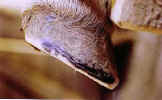
First step in backing up toe.
This is how Dr. Strasser backs up toes on rotated hooves--
dries hooves out less, but needs to be done more often.
Heels STILL to high!
Second step in backing up toe--rounding edges, to create a "mustang roll."
Both are right fore, December 21, l997, the day I first lowered the heels.
This is how to back up toes if you trim less often,
but dries hooves more because you rasp off toe higher up.
This was a mistake. I made too big a mustang roll,
and rasping back so much wall does dry the hoof out.
Also, Jaime feels that taking more hoof wall off higher up interferes with the "tamping"
needed to stimulate the growth of thicker hoof walls ("callusing").
Note that the mustang roll on a wild horse specimen is not
as extreme as how I backed up Max's toes at one point.
Foundered Horses especially need their heels low and toes kept short
and backed up to reduce leverage on the already weakened laminae.
Long heels and toes move the base of support too far forward.
This neglected mare could barely walk.
So—we pulled the shoes in late June of ’97 and began. The width of the white line at the time was 3/4 of an inch, and the toes were dished and around 4-1/2 inches long. (The toes got this long because my farrier did not tell me he was quitting until Max was already well overdue for a reset. This delay, plus others like it in the past, convinced me I would have to learn how to do my own work if I could ever hope to keep Max done in a timely fashion.) Not realizing that this experiment would later prove so successful, I did not photograph his feet when he was first de-shod. The first photos of my hoof experiments were in late October, ’97. However, I am including photos of his feet in ’93, right after the resection. Since ’93, there had not been very much improvement, in terms of the white line still remaining 3/4 of an inch wide at the toe, despite years of pros shoeing him. His heels and frogs remained too narrow for years as well. In other words, years of bar shoes did not lead to any structural improvements.
Back to home page--Table of Contents
Article in sections with "thumbnail" photos for fastest downloads:
1 9 17
2 10 18
3 11 19
4 12 20
5 13 21
6 14 22
7 15 23
8 16 24
NAVICULAR
Article in sections with full-sized photos for print-outs:
1 9 17
2 10 18
3 11 19
4 12 20
5 13 21
6 14 22
7 15 23
8 16 24
NAVICULAR
To Strasser case studies--thumbnail photos for faster downloads
To Strasser case studies--large photos
Please sign my guest book! Photos of my pets My farm
Share Barefoot success stories on this page
Buy or sell used HORSE BOOTS Natural board Barn Listings
Click here to subscribe to naturalhorsetrim
(I moderate this listserv to weed out "fluff.")
Send Email to Gretchen Fathauer, or call (740) 674-4492
Copyright by Gretchen Fathauer, 2015. All rights reserved.